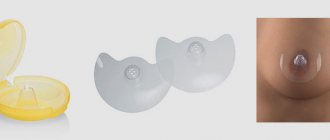It’s wonderful when mothers can breastfeed their babies, and for a long time at that. This is inherent in nature, and the longer the baby suckles, the stronger his immunity will be. After all, for him it is an irreplaceable, most useful and valuable food. But the time comes when a mother begins to think about how to properly stop breastfeeding. Of course, you should listen to the advice of lactation experts so that weaning does not in any way harm either the baby or the mother.
What do the experts say?
The question of the duration of lactation concerns only the mother and baby. Today there are many different opinions, including pediatricians from the World Health Organization, that it is recommended not to wean a baby until two years of age or more. Although many doctors believe that, as a rule, after a year a child no longer eats mother’s milk, but complementary foods. He already eats vegetable soups, meat, dairy products, that is, he eats the usual family food. But if after a year the baby feeds only on breast milk, then this is absolutely wrong. Complementary feeding per day should be at least 600-700 grams, and if this does not work out, then this is an incorrect feeding system. According to the theory, putting a child to the breast after a year has not so much biological (nutritional) expediency as it ensures closeness between the child and the mother. Therefore, how many times and for how long to breastfeed your baby is a personal matter for each mother and her family. WHO pediatricians recommend:
- Be sure to feed your baby until 6 months and no less if the mother can do it;
- It is advisable to breastfeed for up to a year;
- if mother and child are comfortable and they want it, then you can continue to feed as much as you like.
Dr. Komarovsky himself, a famous pediatrician and author of his own methods for treating children, including on the issue of breastfeeding, advises to adhere to the same recommendations.
When should you wean your baby?
The most important rule is not to listen to the examples of friends, neighbors and grandmothers. There are those who are guided by the desire to lead an independent lifestyle, the desire to start actively playing sports (although breastfeeding is not a hindrance to this at all), and strange beliefs that milk after a certain time (after 9 months, after a year, after a year and a half, etc.) becomes not only less nutritious, but also harmful.
You can’t call it anything else, like a belief. It's something "grandma said." But we, as literate and modern people, should rely not on fairy tales, but on scientific evidence, medicine and physiology. Milk is produced under the influence of the hormone prolactin; with constant breastfeeding, its quantity will not decrease, and with proper nutrition, its composition will be as rich as in the first months of breastfeeding.
You can wean your child from breastfeeding no earlier than one year, unless there are reasons for emergency weaning. According to the recommendations of the World Health Organization, breastfeeding should be stopped after one and a half to two years.
But everything is individual, it is very important that not only the child, but also the nursing mother herself is ready for this. After all, for a woman this is also an important psychological moment; it is close contact with the child. It is important not only for the baby, but also for the mother.
Weaning too early is not recommended, since it is impossible to wean a child from breastfeeding before the age of 1.5-2 years, not only because the child may not be ready for this yet, but also because there may be consequences for the woman. In this case, the risk of lastostasis, the appearance of painful lumps in the mammary glands, increases. There is also an early hormonal change in the body, which can lead to various hormonal disruptions later, as well as prolonged release of milk from the mammary glands after breastfeeding ends.
How do you understand that this moment has arrived?
As mentioned above, breast milk is very beneficial for a small body, so it is very important for the mother not to make a mistake and to start weaning her baby correctly. Then this process will be as painless as possible for both mother and baby. You can think about this when the baby turns one year old. Milk no longer has the same meaning as it did a few months ago, but basically only provides an opportunity to feel mother’s closeness and care.
Situations are different, and not all mothers have the patience to feed the baby until the milk runs out naturally. This is scientifically called involution, when the mother’s milk disappears on its own and is no longer released from the mammary glands. But you can wait for this for a year or two, or even more. Dr. Komarovsky's opinion is that there is no need to wait for involution to wean the baby from the breast. A child at this age is already able to digest adult food, and the mother has already fulfilled her duty towards him by breastfeeding him for at least 6 months. Further, again at will, if it is so convenient for mother and child, then they can continue this connection.
It may also happen that the child himself refuses to breastfeed due to malnutrition, but this happens extremely rarely. Basically, children are ready to suck on their mother’s breast almost until kindergarten.
The next circumstance that can force a mother to stop breastfeeding is going to work or leaving urgently. For some, this will go smoothly - without stress and hysterics, but for others, they will have to look for all sorts of tricks, because the baby does not want to give up his usual diet. There is no way to do this without involving your grandmother or relatives.
Emergency weaning
Sometimes situations arise when a woman urgently needs to stop breastfeeding. A number of reasons require stopping breastfeeding for a long period, but there are reasons when it is only possible to take a break from breastfeeding. The second option, of course, is better; if it is possible to continue breastfeeding in the near future, and the child has not yet reached the age of 1.5-2 years, then lactation must be maintained.
Reasons for emergency weaning may include:
- detection of HIV infection
- hepatitis A
- syphilis
- open form of tuberculosis
- cancer in a woman
- development of purulent mastitis
- taking medications that are incompatible with breastfeeding
The last two reasons may allow you to continue breastfeeding. To do this, you need to express milk during the treatment period, and at the end of it you can continue to breastfeed, the volume of milk produced will become the same when the child again consumes his usual amount of breast milk.
Medication
This is the most common method now. Medications are used that will help end lactation painlessly in a couple of days. It is important not to use them yourself, but to consult your doctor and get a prescription for them. Even after taking these medications, it will be necessary to express milk from the breast to prevent stagnation. It is not recommended to express milk until the last drop, so that new milk does not remain, but little by little, relieving the feeling of heaviness in the chest.
Weaning a child off breastfeeding
It is important to take into account not only the mother’s desire, but also the baby’s readiness to completely switch to “adult” nutrition. You can check this with a simple test.
Signs that your baby is ready to wean off breastfeeding:
- most of the baby teeth have erupted;
- the baby has learned to chew hard pieces of food thoroughly;
- the daily menu includes three main meals and 2-3 additional ones;
- when you refuse to breastfeed a child, he quickly becomes distracted and switches his attention to toys;
- the baby can fall asleep without your participation;
- the number of breastfeedings is less than four times a day.
There are different ways of weaning. Choose the one that best suits your situation.
Natural process
Psychologically the healthiest, but takes a lot of time. Conscious soft weaning can last up to six months.
Just 5 steps will help you wean your baby off breastfeeding:
- Stop suckling that is not daytime feeding.
- Replace hanging on your chest before bed by reading a fairy tale.
- Start your morning not with feeding, but with games.
- Have a hearty dinner before bed.
- Replace night feedings with hugs and petting.
Step by step method
This method involves sequential steps that will help complete the feeding. Please note that gentle weaning is extended over a long period of time.
- Eliminate “calming feedings.” It is better to start after six months, when the baby becomes more active, and the mother can already distinguish between real hunger and the need for the breast due to a bad mood.
- Remove lunchtime supplementary feeding. Eating a nutritious lunch will reduce the possibility of “hanging on your chest.”
- Stop morning feeding. Offer your child freshly cooked porridge for breakfast.
- The most difficult stage is to exclude food before bedtime.
- The last stage is difficult emotionally. Finish breastfeeding by completely eliminating nighttime latching.
Properly selected clothing will provide additional assistance in weaning - do not wear a pronounced neckline. At night, send the father to the child.
Abrupt weaning
Doctors warn that the method can cause severe stress in the child. If breastfeeding occurred no more than twice a day, then problems with abrupt weaning should not arise.
Method technology:
- Reduce the number of applications.
- Eliminate all breastfeeding. If this is not possible, then leave only night ones.
- Avoid latching completely.
Grandma's ways
This technique is used, most likely, out of ignorance of others, more humane ones. The result will be in a few days - the baby will wean off the breast.
Algorithm of actions:
- The child needs to be sent to visit his grandmother.
- Meanwhile, mom is bandaging her chest with a sheet.
The consequences are dangerous with severe stress and health problems. Breast ligation may result in mastitis.
There is another method that was previously widely used. Its essence is to smear the nipple areolas with brilliant green, mustard or wormwood tincture. The child himself will refuse to feed because of the bitter taste.
Recommendations from pediatricians
Pediatric doctors offer the following advice to mothers who want to stop breastfeeding:
- Distract your baby by interacting with other family members when he starts searching for the breast.
- Take your child in your arms more often, give him more tactile sensations outside the moment of feeding.
- Feed porridge in the morning and reduce daytime feedings, making the main ones more filling.
- At night, simply rock the baby to sleep; if he wakes up, do not breastfeed.
Stopping breastfeeding naturally
This method is the longest, but acceptable, since it does not cause psychological or physical damage to the baby’s health. If you listen to some of Dr. Komarovsky’s advice, you can achieve maximum efficiency:
- unnecessary feedings should be gradually removed and replaced with walks, games and other entertainment;
- try to give porridge for breakfast in the morning instead of the usual breast;
- reduce and then completely replace daytime attachments to mother’s breast with rocking motions and lullabies;
- try to breastfeed your baby less and less each time in the evening before bed. It’s better to feed him a hearty dinner and then rock him in your arms;
- gradually move away from nightly breastfeeding and replace it with motion sickness.
As pediatrician Komarovsky advises, the mother should offer the baby adult food more often so that he quickly forgets breast milk. Naturally, the child will immediately refuse cereals and soups and will continue to demand the breast. Over time, mother and baby will overcome this long transition from one environment to another. Mom's milk will gradually begin to disappear.
How exactly should weaning proceed?
So, your body is ready to stop lactation, the baby is put to the breast no more than 3 times a day, now you can move on to ending breastfeeding.
How to stop it correctly? Gradually or suddenly, once and for all? It is possible to use both methods, but gradual weaning is preferable; it is less traumatic for the child’s psyche. After all, for a long time he had such close contact with his mother and its sudden cessation would be a great stress for him, but sometimes this path is possible.
It is very important that the mother does not hesitate when starting weaning. The child will feel any of her doubts and this will only add to his anxiety. If the mother is confident in her actions and the correctness of her decision, then this decision will be much easier for the baby.
- Reducing the frequency of feedings is already a stage of weaning
At the same time, it is important to exclude all possible “provocations” of the baby to attach to the breast. There is no need to change clothes in front of him or walk around in open blouses, because very often the child may not be hungry, and when he sees his mother’s breast nearby, he will want to suck it out of boredom. If a child asks for the breast for a couple of minutes for the sake of play, then you just need to distract him, if you can’t ignore him.
- If the child falls asleep only with the breast, then the next step will be to teach him to fall asleep without the breast.
First, the baby needs to learn to fall asleep during the day without the breast. To do this, you need to put him in bed during his usual nap and tell him that mom needs to go away for a minute to do something. Leave for 30-40 seconds, and then return, if the baby demands the breast, then give it to him, but every day the time of your absence should increase and in a couple of weeks your efforts will be crowned with success, when you return, you will see your baby sleeping sweetly. If your child runs after you when you leave, don't get angry with him, just take him back to bed.
- The next step is to teach your baby to fall asleep without the breast at night. It is carried out in the same way as the previous stage.
If the baby no longer requires breastfeeding during the day, then gradually reduce the number and duration of night feedings. If their number, on the contrary, has increased sharply, it means that the child is not ready for weaning and it is worth taking a step back. This may also be indicated by the fact that the child began to suck his lower lip, finger, or anything else. This suggests that the child is experiencing this situation very hard internally and is not ready for it. Then it is better to postpone the weaning for a while.










